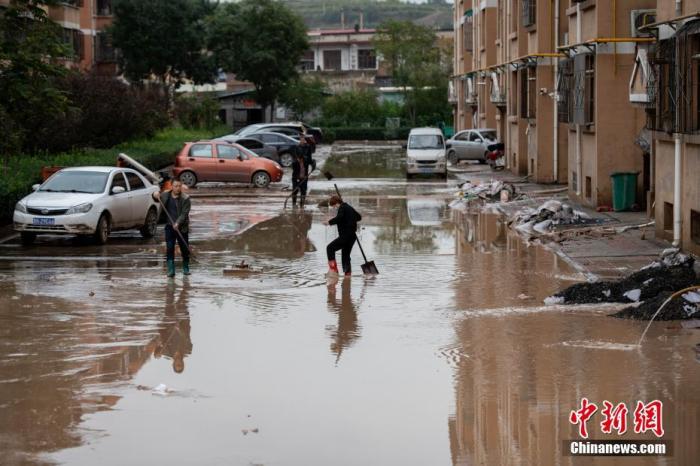China News Service, Taiyuan, October 10 (Wu Qiong) The reporter learned from the Shanxi Provincial Emergency Management Department on the 10th that the recent severe flooding disaster in Shanxi has caused 1,757,100 people in 76 counties (cities, districts) in 11 cities and 120,100 people in the province. People were urgently transferred and resettled, 2.8496 million mu of crops were affected, and more than 17,000 houses collapsed.
On October 10, local villagers cleaned up water in Wenjiagou Village, Yitang Town, Jiexiu City, Shanxi Province.
A few days ago, affected by continuous rainfall, the water level rose after the flood peak of the Jiexiu section of the Fenhe River passed, and the embankment and some residential houses and grain fields along the river were flooded. The local government organized relevant departments to fight floods at the scene, and the affected people actively carried out self-rescue.
Photo by China News Agency reporter Wei Liang
In response to the recent severe floods in Shanxi, the National Disaster Reduction Commission and the Ministry of Emergency Management launched a national level IV disaster response emergency response on October 9.
Shanxi promptly activated the emergency mechanism for guaranteeing financial funds for flood prevention and relief at the provincial level, and fully supported the disaster-stricken areas in flood prevention and relief work.
In response to emergencies, Shanxi mobilized personnel and organized protection of embankments, implemented safety avoidance measures from village to village, household by household, and evacuated the masses to ensure the safety of important facilities and nearby villages to prevent secondary disasters.
In four rescue operations in the Wuma River section of Qingxu County, Taiyuan City, Ciyao River Fenyang Yanwu Section of Luliang City, Xiaolian Village Section of Xiaoyi, and Xinjiang Section of Fenhe River, more than 42,390 people were transferred and resettled, and 6,080 people were involved in rescue operations. There are more than 970 machinery and vehicles, more than 184 generators, pumps, and more than 21,800 cubic meters of earth and stones.
After continuous fighting, as of 16:30 on October 8, the Xinjiang section of the Fenhe River had broken and closed, and the dam body reinforcement project is currently being further implemented.
At 17:00 on the same day, all the breaks in the Yanwu section of Ciyao River in Luliang City were completely blocked.
At present, efforts are being organized to step up the repair and reinforcement of the Wuma River and Xiangyu River dams in Qingxu County, Taiyuan City, and block the breaching dykes.
The Xiaojie village section of Ciyao River in Luliang City is still under emergency rescue.
At 21:20 on the 8th, the upper line (north direction) of the Nantongpu Railway, which was interrupted by heavy rainfall, was rushed through. The rush for the downstream line of the Changyuan River Railway Bridge is still in progress.
Affected by heavy rainfall, there are still 6 coal mines that suspend production on their own due to abnormal underground water gushing. After the coal mines conduct a safety risk assessment, they can resume production after safe production is not affected.
After the disaster, in order to effectively guarantee the basic life of the displaced and resettled people in the disaster, Shanxi Province’s municipal and county three-level emergency departments urgently allocated 3,975 tents, 3212 folding beds, 3000 sets of cotton underwear, 16,306 cotton coats, 10932 quilts and cotton beds. Relief materials such as 8,600 beds of mattresses were used for the resettlement of the victims.
While actively applying for the central disaster relief funds, on October 9, the Shanxi Provincial Department of Finance, together with the Shanxi Provincial Department of Emergency Management, Shanxi Provincial Department of Agriculture and Rural Affairs, and Shanxi Provincial Department of Water Resources, issued an emergency amounting of 50 million yuan in provincial-level rain and waterlogging disaster relief funds for Emergency transfer and resettlement of disaster-affected people, transitional life assistance, restoration and reconstruction of damaged houses, distribution of relief money to the families of those who died due to the disaster, support for the drainage of farmland in the hardest-hit areas, restoration of damage to farmland water conservancy facilities, and materials needed for the restoration of agricultural production Materials, emergency repairs to water-damaged projects and facilities, etc.
(over)

